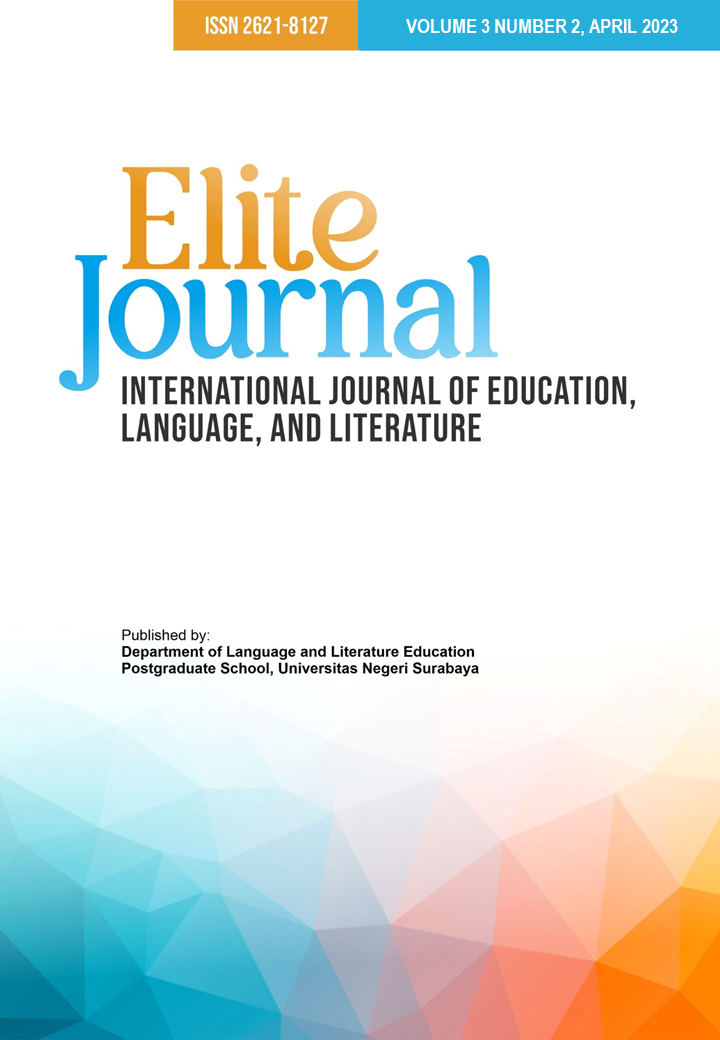CULTURAL CONTENT EVALUATION IN INDONESIAN INTERACTIVE ENGLISH TEXTBOOK FOR MERDEKA CURRICULUM
DOI:
https://doi.org/10.26740/elitejournal.v3n2.p77-87Keywords:
content analysis, culture exposure, EFL textbookAbstract
This research aims to analyze the cultural content in an English textbook that is customized for learning English based on Indonesian Merdeka curriculum which ideally should include a variety of traditional and regional cultures of Indonesia in its textbook. The chosen book is an authoritative book for senior-high grade entitled Bahasa Inggris untuk SMA/MA/SMK/MAK Kelas 10B by Yuniarti Dwi Arini. The objective of this research is to prove and to review the ratio of cultural content that exists within the English interaction textbook of tenth grade. Through analyzing the cultural content, it is hoped that this study is able to improve the cultural quality within other EFL textbooks in Indonesia. The research design for this study is a quantitative method, specifically, a conceptual content analysis. The coding is based upon cultural categories and cultural elements exposure of the content inside the textbook. The finding of this research shows that the percentage of cultural concepts in the analyzed object is 76%, the percentage of practice is 17%, and perspective and person's percentages are 5% and 2% respectively. For the cultural categories, there are a ratio of 55% in the target culture of English speaking country, 24% for the source culture which is from Indonesian culture, and 21% for the international target culture which is a culture that neither the target culture nor the source culture and the culture that originated in a nation that does not regard English as a first or second language.
References
Anggraini, R., Derin, T., Warman, J. S., Putri, N. S., & Nursafira, M. S. (2022). Local Cultures Folklore Grounded from English Textbooks for Secondary High School Indonesia. Elsya: Journal of English Language Studies, 4(3), 263-275.
Arini, Y. D. (2022). Bahasa Inggris untuk SMA/MA/SMK/MAK Kelas 10B. Klaten: Intan Pariwara.
Ayu, M. (2020). Evaluation Cultural Content on English Textbook Used by EFL Students in Indonesia. JET (Journal of English Teaching), 6(3), 183-192.
Balqis, S. A. (2022). AN ANALYSIS OF ENGLISH TEXTBOOK ENTITLED "PATHWAY TO ENGLISH" BASED ON CULTURAL CONTENT AT ELEVENTH GRADE OF SENIOR HIGH SCHOOL (Doctoral dissertation, UIN RADEN INTAN LAMPUNG).
Colson, J. P. (2008). Cross-linguistic phraseological studies, in S. Granger, S., & F.Meunier, F. (eds) Phraseology: An Interdisciplinary Perspective, 191-206. Amsterdam & Philadelphia: John Benjamins Publishing Company.
Cortazzi, M., & Jin, L. (1990). Cultural mirrors, materials and method in the EFL classroom in Eli Hinkel, Culture in second language teaching and learning. Cambridge: Cambridge University Press.
Deris, F., & Shukor, N. (2019). Vocabulary learning through mobile apps: A phenomenological inquiry of student acceptance and desired apps features.
FATA, I. A., GANI, S. A., & HUSNA, N. (2020). Cultural elements: A textbook evaluation in Indonesia. International Journal of Language Studies, 14(4).
Hall, S. (1997). The work of representation in Representation: cultural representationsand signifying practices. Retrieved from www.mcser.org/journal/index.php/ajis/1471
Hall, S. (2016). Cultural studies 1983. In Cultural Studies 1983. Duke University Press.
Hutchinson, T., & Torres, E. (1994). The textbook as agent of change.Kultsum, U. (2022). Investigating Cultural Contents and National Identities In EFL Textbook For Junior High Scool (Master's thesis, Jakarta: FITK UIN Syarif Hidayatullah Jakarta).
Kramsch, C. (1993). Context and culture in language teaching. Oxford: OxfordUniversity Press.
Kramsch, C. (1997). The cultural component of language teaching. British Studies Now,8, 4-7.
Matters, Q. (2014). Standards from the QM higher education rubric. Quality Matters. Recuperado de https://www. qualitymatters. org/sites/default/files/PDFs/StandardsfromtheQMHigherEducationRubric.pdf.
Nadzib, Abu. (2022) Solopos.com "Diterapkan hingga 2024, Ini Teknis Kurikulum Merdeka" (https://www.solopos.com/diterapkan-hingga-2024-ini-teknis-kurikulum-merdeka-1355162.)
Nurjanah, I., & Umaemah, A. (2019). An Analysis of Cultural Content in the Textbook "Pathway to English" for Second Grade in Senior High School. ELT Echo: The Journal of English Language Teaching in Foreign Language Context, 4(1), 83-92.
Permatasari, D. (2022). Multimodal Analysis on The Cultural Content of Indonesian High School English E-Textbooks. ENLIT Journal, 2(2), 111-122.
Qodriani, L. U., & Kardiansyah, M. Y. (2018). Exploring culture in Indonesia English textbook for secondary education. JPI (Jurnal Pendidikan Indonesia), 7(1), 51-58.
Riadini, U. S., & Cahyono, B. Y. (2021). The Analysis of the Culture-Related Contents in an Indonesian English Textbook. Indonesian Journal of English Language Teaching and Applied Linguistics, 5(2), 285-295.
Richards, J. C. (2019, November 11). https://www.professorjackrichards.com/articles/role-of-textbooks/.Retrieved from https://www.professorjackrichards.com
Riff, D., Lacy, S., & Fico, F. (2014). Analyzing media messages: Using quantitative content analysis in research. Routledge.
Ririn, B. (2012) CULTURAL ELEMENTS IN INDONESIAN ENGLISH LANGUAGE TEXTBOOKS FOR PRIMARY SCHOOL.
Syafiqah Yaccob, N., & Md Yunus, M. (2019). Language games in teaching and learning English grammar: A literature review. Arab World English Journal (AWEJ) Volume, 10.
Taniya, T. (2020). AUTHENTIC MATERIAL ORIENTED TASKS IN ENGLISH TEXTBOOKS. ELT Echo: The Journal of English Language Teaching in Foreign Language Context, 5(1), 44-54.
Thompson, A., & Fevre, R. (2001). The national question: sociological reflections on nation and nationalism. Nations and Nationalism, 7(3), 297-315.
Toombs, W. E., & Tierney, W. G. (1993). Curriculum definitions and reference points. Journal of curriculum and supervision, 8(3), 175-95.
Van Den Ham, A. K., & Heinze, A. (2018). Does the textbook matter? Longitudinal effects of textbook choice on primary school students' achievement in mathematics. Studies in Educational Evaluation, 59, 133-140.
Wakhidah, N. J. I., & Adityarini, H. (2021, April). The Representation of World Englishes and Cultural Themes in Senior High School English Textbooks in Indonesia. In Thirteenth Conference on Applied Linguistics (CONAPLIN 2020) (pp. 393-400). Atlantis Press.
Williams, G. (2010). ESL teaching: How language and culture are are interdependent.Language Study.
Yuen, K. M. (2011). The representation of foreign cultures in English textbooks. ELT Journal Advance Access, 1-9
Downloads
Published
How to Cite
Issue
Section
License
Copyright (c) 2023 lukitaning nur jayanti

This work is licensed under a Creative Commons Attribution 4.0 International License.
 Abstract views: 1176
,
Abstract views: 1176
, PDF Downloads: 984
PDF Downloads: 984





